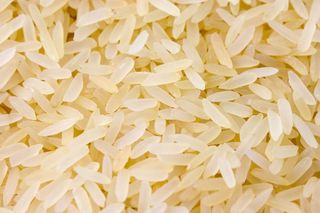
Climate Change Will Soon Zap Rice of Nutritional Value
We’re heading for a diet of bland nutritional tablets reminiscent of a sci fi dystopia.

Increased carbon dioxide in the atmosphere will soon reduce the nutritional value of India’s favorite grain, according to an international research team that analyzed rice samples from field experiments. Specifically, iron, zinc, protein, and vitamins B1, B2, B5, and B9, were reduced in rice grown under the kind of higher carbon dioxide concentrations expected in the second half of this century.
“Rice is not just a major source of calories, but also proteins and vitamins for many people in developing countries and for poorer communities within developed countries,” said Professor Kazuhiko Kobayashi of the University of Tokyo, co-author of the recent study and an expert in the effects of air pollution on agriculture.
Populations in countries with both the highest rice consumption and lowest gross domestic product may experience more malnutrition as the nutritional value of low-cost staple foods like rice declines. Not all varieties of rice responded in the same way, so future research projects may examine the possibility of finding varieties of rice that can remain nutritious despite the change in the atmosphere.
The rice was grown at research sites in China and Japan using an open-field method where researchers build 17-meter-wide (56-foot-wide) plastic pipe octagons elevated about 30 centimeters (1 foot) above the tops of plants within standard rice fields. A network of sensors and monitors measure wind speed and direction to determine how much carbon dioxide is released out of the pipes to raise the local carbon dioxide concentration to the desired experimental level.
“I first started using this technique in 1998, because we knew that plants raised in a plastic or glass house do not grow the same as plants in normal, open field conditions. This technique allows us to test the effects of higher carbon dioxide concentrations on plants growing in the same conditions that farmers really will grow them some decades later in this century,” said Kobayashi.
Local wildlife has sometimes added an additional challenge to the research. “At our first field site, we learned we have to keep all of the pipes and tubes above the ground because raccoons kept chewing through everything and jeopardized the experiment,” said Kobayashi.
Researchers analyzed a total of 18 different varieties of rice for protein, iron, and zinc levels. Nine varieties of rice grown in China were used for the vitamin B1, B2, B5, and B9 analyses. Other common names for the vitamins are thiamine (B1), riboflavin (B2), pantothenic acid (B5), and folate (B9).
Rice is a major staple of Indian diets currently, and forecasts of future Indian diets suggest the country’s total rice consumption will continue to grow at the rate of overall population growth, even as the grain becomes less popular among some demographic segments. Which means that, unless policies and subsidies that encourage rice production and consumption change, Indians in the future will be eating more rice only to gain fewer nutrients.
Related


Amazon’s Echo Dot Kids Is Launching to a Chorus of Concerns
